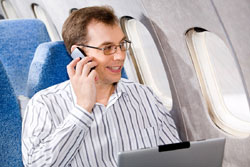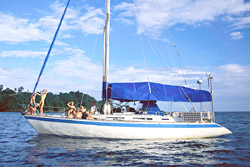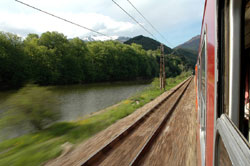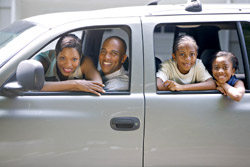- What is motion sickness?
- What causes motion sickness?
- Factors contributing to motion sickness
- How common is motion sickness?
- Symptoms of motion sickness
- Management of motion sickness
- Tips for preventing motion sickness
What is motion sickness?
Motion sickness, or kinetosis, is a common condition experienced by people travelling on planes, cars, trains, and especially on boats. It can even occur when exposed to moving scenes in virtual reality games. It is characterised by symptoms of dizziness, nausea and fatigue.
There are several types of motion sickness, depending on the underlying cause. These include seasickness, carsickness, airsickness, space sickness and simulation sickness. It can also occur on horseback. Motion sickness is a major issue for astronauts during space travel, and for navymen at sea.
What causes motion sickness?
Motion sickness occurs when parts of the inner ear that help control balance are stimulated too much. This can be caused by excessive repetitive motion, such as that experienced while travelling in a moving car, boat, plane, space craft or on amusement park rides.
Movement is sensed by three systems in the body: the eyes, the vestibular system, and the muscle and joint sensory receptors of the limbs (nerve endings). The motion signals transmitted by these three systems communicate information to the brain about the positioning of the body in space and how it should respond to movement.
The most widely accepted explanation for the symptoms of motion sickness is the sensory conflict hypothesis. This states that motion sickness occurs when there is repeated mismatches between the information received from sensory receptors and what is expected from previous experience. Thus, motion sickness occurs when what is seen does not match with what is felt. The inner ear tells the brain that the body is moving, but the eyes convey information that it is stationary. For example, when at sea, the eyes view the static horizon or unmoving interior of boat, while the body feels the rolling of the waves. While travelling in a car, the limbs and ears feel little movement, but the eyes perceive scenery passing by. If the motion sensing organs of the inner ear do not work, then motion sickness does not occur. This suggests that the inner ear is critical for the development of motion sickness, and supports the hypothesis.
Motion is actually not a requirement for motion sickness to occur. It can be experienced during activities such as virtual reality rides and playing video games, or by watching movies shot on a shaky camera. The illusion of motion created by the virtual world, combined with the absence of motion detected by the inner ear, results in mixed messages being sent to the brain.
The symptoms underlying motion sickness are thought to develop as part of the body’s natural defence mechanism. The mixed signals the brain receives lead the brain to conclude that it is hallucinating, and that this hallucination is due to poisoning by a neurotoxin. The brain responds by inducing nausea and vomiting to clear the toxin.
Factors influencing motion sickness
Factors that can exacerbate motion sickness include poor ventilation, anxiety and fear. Heavy meals of spicy, greasy food before and during a trip can upset the stomach further, as can alcohol. Pregnancy is also known to increase susceptibility to motion sickness.
There is a clear variation in individual susceptibility which is not well understood. Some research suggests that there may be genetic factors involved and that it may be possible to inherit a predisposition to motion sickness. This has not been definitively confirmed, though the fact that motion sickness is more common in some ethnic groups helps to support this theory. It has been observed that persons of Chinese or Japanese origin are more vulnerable to motion sickness than those of British ancestry.
How common is motion sickness?

Sex and age also play a role in determining susceptibility. Women are more vulnerable than men, particularly during pregnancy and menstruation. Motion sickness is very common in children older than two years. It peaks at around 9-10 years, then begins to decline into the 20s. This decline may be due to habituation, in which a person stops responding to repetitive stimuli. Infants and children under two years appear to be immune to motion sickness.
People with certain medical conditions are more susceptible to motion sickness. This includes migraine sufferers, those with Meniere’s disease (a disorder of the inner ear), and any patients who have an inner ear disease or vertigo.
Symptoms of motion sickness
The most common symptoms experienced in motion sickness are:
- Nausea;
- Vomiting;
- Dizziness;
- Vertigo;
- Abdominal discomfort;
- Headache;
- Fatigue;
- Pale face and cold sweats;
- Hypersalivation;
- Hyperventilation.
Symptoms gradually improve within 15 minutes of the motion stopping, when stomach motility has returned to normal.
Management of motion sickness

Behavioural therapy
Desensitisation by repeated exposure to the cause of the motion is one of the most effective ways to prevent motion sickness without any side effects. However, this method is specific to the cause. So, if a person becomes desensitised to sea-sickness, his/her vulnerability to car sickness or any other type of motion sickness is not affected.
Behavioural measures such as reducing head movement, gazing at the horizon, lying down, and controlled, regular breathing are all helpful in reducing the severity of symptoms. If there are no windows or it is dark, then closing the eyes or trying to sleep may help. Closing the eyes prevents the conflict that occurs between what is visually perceived and what is sensed by the inner ear. Odours can make motion sickness worse, so try to get some fresh, cool air by opening a window or air vent. It is best to stay in the front seat of a car.
Pharmacological agents
There are two sub-classes of drugs that can aid in treating and preventing symptoms of motion sickness. These are anticholinergic drugs, and antihistamines. The choice of medication is based on trip duration, any underlying medical conditions, concerns about sedation, and personal preference.
To prevent motion sickness symptoms, oral medications should be taken at least 30-60 minutes before travel to allow adequate absorption time.
Antihistamines
Antihistamines are the most commonly used medication for preventing and treating motion sickness, and work by reducing the stimulation to the inner ear. Antihistamines include:
- Oral dimenhydrinate (e.g. Calmx, Dramamine, Triptone)
- Diphenhydramine (e.g. Benadryl)
- Promethazine hydrochloride (e.g. Phenergan)
- Meclizine (e.g. Anivert, Bonine, Dramamine II, Meclocot)
- Cyclizine (e.g. Marezine)
- Cinnarizine (e.g. Stugeron)
Dramamine and Bonine are effective for short trips or if symptoms occur intermittently.
Promethazine reduces nausea and may be more effective than other antihistamines, but is the most sedating medication and can impact on psychomotor performance. Meclizine is less sedating and only needs to be taken once a day. Dimenhydrinate has also been shown to impair psychomotor performance compared with placebo, though not to the extent of promethazine.
Only dimenhydrinate and diphenhydramine are recommended for use in children over the age of 2.
Anticholinergics
The most common anticholinergic used is hyoscine, also called scopolamine. Another anticholinergic drug that is used is zamafenacin. Hyoscine works by blocking the cholinergic input from the vestibular organs to the CNS, thereby inhibiting the vomiting impulse activated by motion sickness. Hyoscine is available in several forms, including oral tablets, as an IV, as a topical gel application or as adhesive transdermal patches.
Transdermal patches of hyoscine are recommended for longer trips, as they can be effective for up to three days, while tablets can be taken every six hours. The transdermal patch is applied behind the ear at least 4 hours before departure, and is changed every three days as needed. For maximum effect, the patch should be applied 8 hours before departure. Oral hyoscine is effective for 6-8 hours and can be used for short journeys, or for the interval until an applied patch takes effect. In gel form, hyoscine is most effective when smeared on the arm or neck and covered with a bandage.
Other medications
All motion sickness medications can reduce alertness, and must be used with caution by people who are operating vehicles or heavy machinery. Drinking alcohol or taking other CNS depressants (sleep aids or sedatives) while taking anti-motion sickness drugs increases the side effects of the drugs.
People with low angle glaucoma, GI obstruction or urinary retention (e.g. due to prostatic hypertrophy) should avoid these medications. Patients with any cardiovascular, pulmonary, kidney or liver disease should exert caution when taking these medications.
Another drug that is sometimes prescribed is ondansetron (e.g. Zofran), which was originally developed to treat nausea associated with cancer chemotherapy. This appears to be safe for use in children under the age of six.
Some newer medications currently being developed include a class of compounds known as neurokinin-1 (substance P) antagonists. The neurokinins are being investigated for the control of nausea following cancer chemotherapy, as well as nausea related to motion sickness. The first of these drugs available is aprepitant (e.g. Emend).
Natural treatments
Several alternative non-pharmacological remedies have been tried for treating motion sickness. Complementary therapies include acupressure, acupuncture and herbal remedies.
Ginger
Ginger root is a highly effective antiemetic without any side effects. The oils contained in ginger appear to relax the intestinal tract as well as mildly depressing the central nervous system. Some of the most effective forms of ginger include the powdered, encapsulated form, ginger tea prepared from sliced ginger root, or candied pieces. Sucking on crystallised ginger or drinking ginger tea can help relieve nausea. All forms of ginger should be taken on an empty stomach.
Tips for preventing motion sickness
Use visual fixation so that your eyes see the same motion that your body and inner ears feel (e.g. sit in the front seat and look ahead, or watch the distant horizon)
- Choose a seat where motion is felt the least:
- In a car, sit in the front seat and look at the distant scenery
- On a boat, sit in the middle cabin, or go up on deck and watch the horizon
- In an airplane, sit by the window and look outside, or choose a seat over the wings where the motion is minimised.
- Keep your head and body as still as possible
- Close your eyes
- Lie down on your back
- Sit facing forward and in a reclining position
- Do not read
- Get fresh air by opening a window or going up to the deck of a boat
- Do not drink alcoholic beverages or smoke, as this can increase nausea
- Eat small amounts of low-fat, starchy foods and avoid eating strong-smelling or spicy and greasy foods
- Avoid food and drink on short airplane trips
- On long journeys, eat and drink small amounts, but frequently
- Do not watch or talk to others who are experiencing motion sickness
- Anxiety worsens symptoms. Use relaxation techniques (e.g. abdominal breathing) to occupy your mind
- Soft drinks can help to settle the stomach, and chewing gum or breath mints help prevent saliva from building up in the mouth.
References
- Kumar P, Clark C. Motion sickness. In: Clinical Medicine 2005. Edinburgh: Elsevier Saunders.
- Yates BJ, Miller AD, Lucot JB. Physiological basis and pharmacology of motion sickness: An update. Brain Research Bulletin. 1998; 47(5): 395–406.
- Warwick-Evans LA, Symons N, Fitch T, Burrows L. Evaluating sensory conflict and postural instability theories of motion sickness. Brain Research Bulletin. 1998; 47(5): 465–9.
- Spinks AB, Wasiak J, Villanueva EV, Bernath V. Scopolamine (hyoscine) for preventing and treating motion sickness (review). The Cochrane Library. 2008; 2: 1-23.
- Golding JF, Gresty MA. Motion sickness. Curr Opin Neurol. 2005; 18: 29-34.
- Golding JF. Motion sickness susceptibility. Autonomic Neuroscience: Basic and Clinical. 2006; 129: 67–76.
- Conzen K. Chapter 6. Non-infectious risks during travel: Motion sickness. In: Traveler’s Health: Yellow Book [online]. Centres for Disease Control and Prevention. 18 June 2007 [cited 30 June 2008]. Available from URL: http://wwwn.cdc.gov/ travel/ yellowBookCh6-MotionSickness.aspx
- Blesa W, Bosa JE, Kruit H. Motion sickness. Current Opinion in Neurology. 2000; 13: 19-25.
- White B. Ginger: An overview. Am Fam Physician. 2007; 75: 1689-91.
- Stern RM, Jokerst MD, Muth ER, Hollis C. Acupressure relieves the symptons of motion sickness and reduces abnormal gastric activity. Alternative Therapies in Health and Medicine. 2001; 7(4): 91-5.
All content and media on the HealthEngine Blog is created and published online for informational purposes only. It is not intended to be a substitute for professional medical advice and should not be relied on as health or personal advice. Always seek the guidance of your doctor or other qualified health professional with any questions you may have regarding your health or a medical condition. Never disregard the advice of a medical professional, or delay in seeking it because of something you have read on this Website. If you think you may have a medical emergency, call your doctor, go to the nearest hospital emergency department, or call the emergency services immediately.


 Use visual fixation so that your eyes see the same motion that your body and inner ears feel (e.g. sit in the front seat and look ahead, or watch the distant horizon)
Use visual fixation so that your eyes see the same motion that your body and inner ears feel (e.g. sit in the front seat and look ahead, or watch the distant horizon)





